The Canon A-1 manual provides comprehensive guidance for mastering this iconic 35mm SLR camera, produced from 1978 to 1985. It details operation, maintenance, and troubleshooting, ensuring optimal use of its advanced features like five AE modes and a built-in LED display. This resource is essential for photographers seeking to unlock the full potential of the A-1.
1.1 Historical Background of the Canon A-1
The Canon A-1, introduced in 1978, marked a significant milestone in the evolution of single-lens reflex (SLR) cameras; Produced until 1985, it was a landmark model that combined advanced features with user-friendly design, appealing to both professionals and enthusiasts. The A-1 was part of Canon’s FD-mount system, which offered compatibility with a wide range of lenses, enhancing its versatility. Its release coincided with a period of rapid innovation in photography, making it a symbol of technological advancement. The camera’s historical importance lies in its integration of five automatic exposure (AE) modes and a built-in LED display, setting new standards for SLR cameras. These innovations not only influenced future camera designs but also solidified Canon’s reputation as a leader in the photography industry. The A-1 remains celebrated for its durability, precision, and adaptability, making it a cherished piece of photographic history.
1.2 Key Features and Specifications
The Canon A-1 boasts an impressive array of features that made it a standout in its era. It offers five automatic exposure modes, including Shutter Priority, Aperture Priority, and Program AE, providing photographers with flexibility and control. The camera is equipped with a built-in LED display, offering clear and precise exposure information. Its metering system supports center-weighted averaging, ensuring accurate light measurements. The A-1 accepts Canon FD-mount lenses, offering compatibility with a wide range of optics. It supports film speeds from ISO 12 to 3200, allowing for versatility in various lighting conditions. Additional features include manual override capabilities, exposure compensation, and multiple exposure options. The A-1’s robust build and ergonomic design make it both durable and user-friendly. These specifications underscore its reputation as a versatile and powerful tool for photographers, catering to both creative and technical demands.
1.3 Importance in Photography History
The Canon A-1 holds a significant place in photography history as one of the most advanced SLR cameras of its time. Released in 1978, it introduced innovative features that influenced the trajectory of camera development. Its five automatic exposure modes and built-in LED display set a new standard for versatility and user control. The A-1’s adaptability across various photography genres made it a favorite among both professionals and enthusiasts, contributing to its enduring popularity. This camera not only advanced technical capabilities but also democratized access to sophisticated photography tools, leaving a lasting legacy in the evolution of photographic equipment and practices.

Camera Components and Layout
The Canon A-1 features a robust design with intuitive controls, including a top deck with mode dials, shutter speed, and aperture settings. Its FD lens mount supports a wide range of lenses, while the viewfinder provides clear framing and metering information. The camera’s ergonomic layout enhances usability, making it a reliable tool for photographers.
2.1 Top Deck Controls and Functions
The Canon A-1’s top deck is a command center for photographers, offering intuitive controls for seamless operation. The mode dial on the left allows selection from five AE modes, including Program, Shutter Priority, Aperture Priority, and Manual. Adjacent to it is the shutter speed dial, which enables precise control over exposure times, ranging from 1/1000th of a second to 30 seconds, plus a Bulb setting. A locking mechanism prevents accidental changes. On the right, the LCD display provides clear visual feedback on settings, including aperture, shutter speed, and metering information. Additionally, a battery check button ensures power status is easily verifiable. These controls are ergonomically designed, making the A-1 both functional and user-friendly, catering to both amateur and professional photographers seeking precise control over their craft.
2.2 Lens and Mount System Overview
The Canon A-1 features the Canon FD mount system, designed for compatibility with a wide range of Canon FD lenses. This system ensures secure attachment via a breech-lock mechanism, providing stability and optical alignment. The FD lenses are renowned for their high-quality optics, offering both prime and zoom options to suit various photographic needs. The mount’s design allows for smooth lens changes, while the aperture control mechanism enables precise adjustments. Compatible with a broad selection of FD-series lenses, the A-1 offers versatility for photographers. Although the FD mount is not directly compatible with later Canon EOS EF lenses, adapters are available for modern use. This system remains a cornerstone of the A-1’s functionality, supporting its reputation as a versatile and reliable camera. The FD mount’s durability and compatibility with diverse optics make it a key feature of the A-1’s design.

2.3 Viewfinder and Metering System
The Canon A-1’s viewfinder is highly regarded for its clarity and functionality, offering a 97% coverage of the actual image area with a 0.8x magnification. It incorporates a split-image microprism for precise focusing and a horizontal needle for exposure level indication. The viewfinder also displays essential information such as aperture, shutter speed, and flash readiness. The built-in TTL (Through-The-Lens) metering system utilizes a silicon photocell for accurate light measurement, supporting multiple modes like Program AE, Aperture Priority, Shutter Priority, and Manual. The digital LED display inside the viewfinder provides a clear readout of exposure settings, enabling precise control. This advanced metering system, combined with the intuitive viewfinder design, makes the A-1 a versatile tool for photographers seeking both convenience and manual control. The system’s reliability and accuracy were groundbreaking for its time, cementing the A-1’s reputation as a refined photographic instrument.
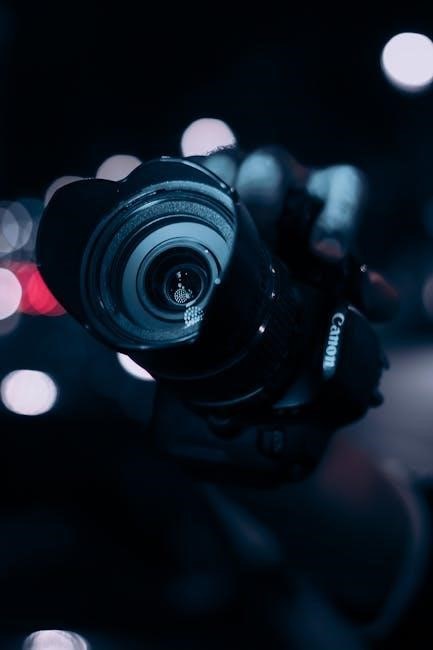
Operating the Canon A-1
Mastering the Canon A-1 involves understanding its intuitive controls, loading film, setting the battery, and utilizing its shooting modes. This section guides users through essential operations for optimal performance.
3.1 Loading Film and Battery
Properly loading film and installing the battery are essential steps to ensure the Canon A-1 functions correctly. Start by inserting the battery into the compartment, located on the bottom of the camera. Next, load the film by opening the back cover and aligning the film leader with the take-up spool. Advance the film to the first frame using the film advance lever. Ensure the film counter is correctly set and the film is securely seated. Close the back cover and check the battery and film counter to confirm everything is ready for use. Always handle the film carefully to avoid exposure to light. For detailed steps, refer to the manual or accompanying diagrams to ensure proper loading techniques. This process ensures your camera is ready for shooting, providing reliable performance for capturing high-quality images.
3.2 Basic Shooting Controls and Modes
The Canon A-1 offers intuitive controls and versatile shooting modes, making it accessible for both beginners and experienced photographers. The primary shooting modes include Program AE, Shutter Priority (Tv), Aperture Priority (Av), and Manual (M) mode. Program AE allows fully automatic exposure control, while Tv mode lets users set the shutter speed for creative effects like motion blur. Av mode enables manual aperture adjustment for depth-of-field control. Manual mode provides full control over both shutter and aperture settings. The camera also features a built-in LED display for easy monitoring of settings. Additional controls include the ISO sensitivity dial and the film advance lever. These controls work harmoniously, allowing users to switch seamlessly between modes and adjust settings based on lighting conditions and creative goals. This flexibility ensures the A-1 adapts to various photography scenarios, offering both convenience and precision. The design emphasizes ease of use while maintaining advanced functionality.
3.3 Advanced Shooting Modes and Techniques
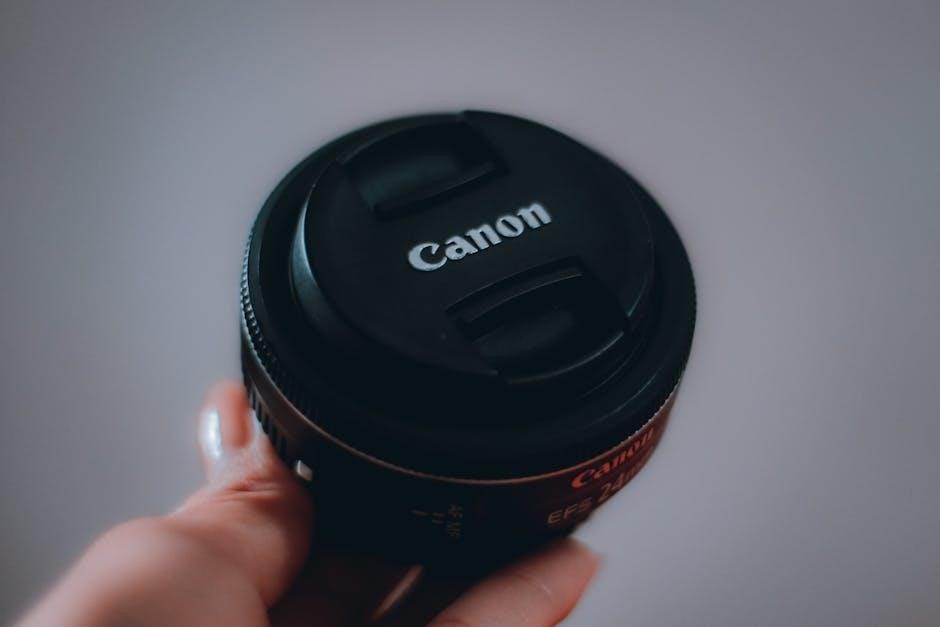
The Canon A-1 offers advanced shooting modes and techniques for experienced photographers. Multiple exposure capabilities allow for creative layering of images on a single frame. Manual override is achieved by disengaging the lens aperture ring from the A mark, enabling precise control over exposure settings. The camera also supports expanded metering and exposure compensation ranges, including EV memory, which enhances versatility in challenging lighting conditions. Additionally, the A-1 accommodates advanced accessories like the Speedlite 199A flash and Motor Drive MA-8, enabling faster shooting and enhanced flash photography. These features, combined with the camera’s robust build and intuitive design, make it a powerful tool for photographers seeking advanced creative control. The A-1’s manual mode and specialized techniques ensure unparalleled precision, catering to professionals and enthusiasts alike.
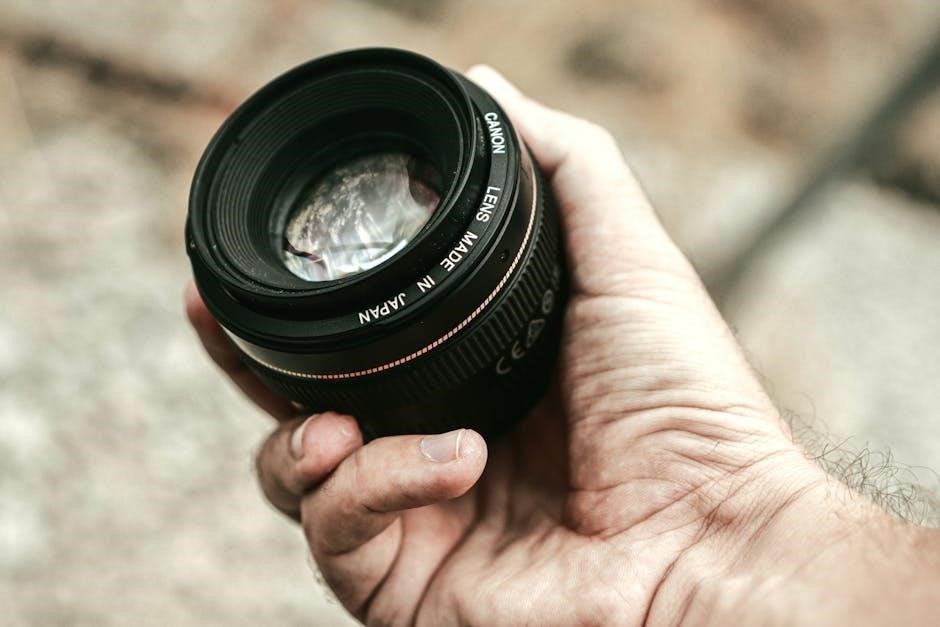
Exposure and Metering
The Canon A-1 features advanced metering modes, including center-weighted and spot metering, ensuring precise exposure control. It offers exposure compensation and manual mode operations, with an LED display showing metered values and warnings for over/under exposure, providing photographers with both automatic and manual options for optimal results in various lighting conditions.
4.1 Metering Modes Explained
The Canon A-1 features a sophisticated metering system, offering two primary modes: center-weighted averaging and spot metering. Center-weighted averaging provides a balanced exposure reading by prioritizing the central area of the frame, ideal for everyday shooting. Spot metering, on the other hand, allows precise control by measuring light from a specific, smaller area, useful for high-contrast scenes. The camera’s built-in LED display provides clear feedback, with arrows indicating over or underexposure and a center mark for optimal exposure. Additionally, the A-1 supports manual mode overrides, enabling photographers to adjust settings for creative control. This versatile metering system, combined with the camera’s advanced features, makes the A-1 adaptable to various lighting conditions and photographic styles, ensuring high-quality results with both automatic and manual operations.
4.2 Exposure Compensation Techniques
Exposure compensation on the Canon A-1 allows photographers to fine-tune their shots for precise results. The camera supports manual overrides, enabling adjustments for creative control. To compensate for exposure, users can move the FD lens aperture ring from the A mark, overriding the automatic setting. The LED display provides clear feedback, with arrows indicating over or underexposure and a center mark for optimal exposure. For more precise control, the AE mode selector can be switched to Tv (Time Value) mode, allowing manual shutter speed adjustments via the AT dial. Additionally, the A-1 features an EV memory function, enabling photographers to store exposure values for consistent results in varying lighting conditions. These techniques, combined with the camera’s advanced metering system, offer exceptional flexibility for achieving desired photographic effects, making the A-1 a versatile tool for both amateur and professional photographers.
4.3 Manual Mode Operations
Manual mode on the Canon A-1 offers precise control over exposure settings, allowing photographers to bypass automatic features for creative freedom. To engage manual mode, users must disengage the lens aperture ring from the A mark and switch the AE mode selector to Tv (Time Value) or other manual modes. Shutter speed can then be adjusted using the AT dial, with the LED display providing digital feedback to guide adjustments. The camera’s metering system aids in achieving accurate exposures, but full manual control enables photographers to override automatic settings for specific effects. Additionally, the A-1’s EV memory function allows for storing exposure values, ensuring consistency across multiple shots. This level of manual control makes the A-1 a powerful tool for photographers who prefer hands-on adjustments, offering unparalleled flexibility in various lighting conditions and creative scenarios.
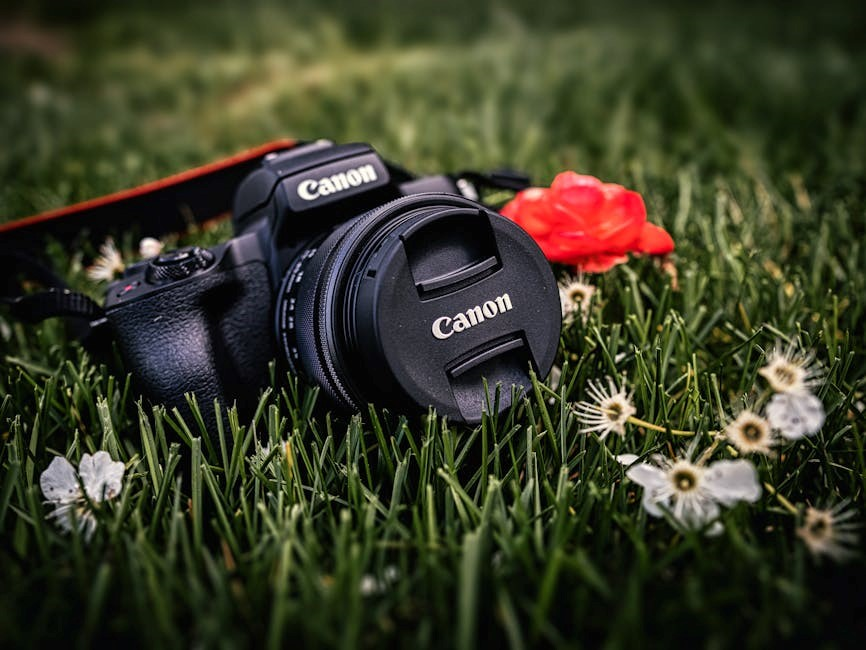
Flash and External Accessories
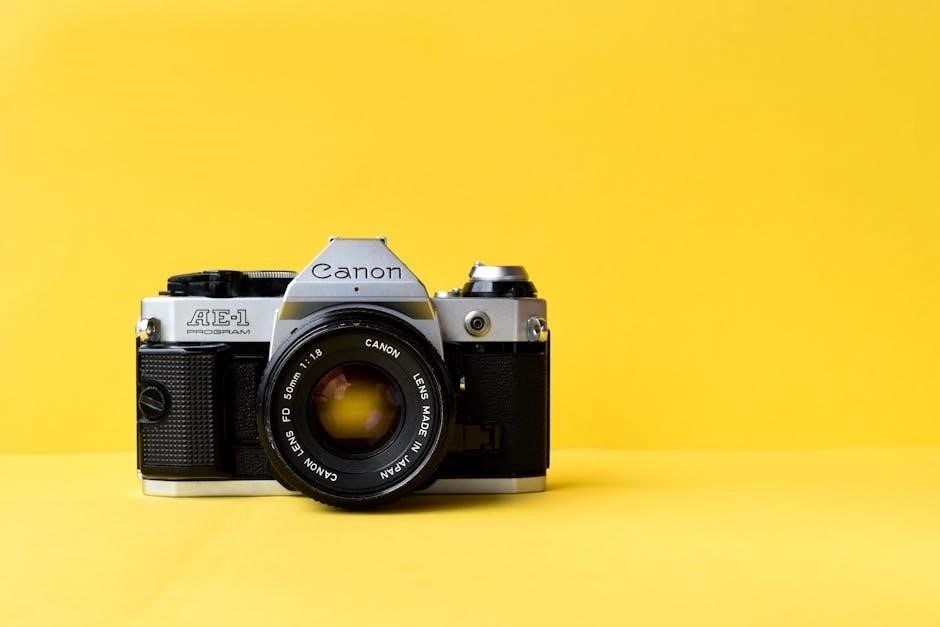
The Canon A-1 supports various external accessories, including compatible flashes like the Speedlite series and motor drives, enhancing its functionality for advanced flash photography and motorized operations.
5.1 Built-in Flash Capabilities
The Canon A-1 does not feature a built-in flash but supports external flash units like the Speedlite 199A for enhanced lighting control. Manual flash operation is achieved by adjusting the FD lens aperture ring, ensuring precise exposure. The camera’s LED display provides aperture values, aiding manual flash photography. This system offers flexibility for photographers seeking advanced lighting techniques without relying on automatic flash modes. The A-1’s compatibility with external flashes expands its versatility in various lighting conditions. By using the Speedlite series, users can achieve professional-grade results, making the A-1 a robust tool for creative and technical photography applications. This manual flash control ensures that photographers maintain full creative oversight, aligning with the camera’s emphasis on user control and customization. The A-1’s flash capabilities, while external, remain integral to its functionality and photographic potential.
5.2 Compatible External Flashes
The Canon A-1 is compatible with a range of external flashes, including the Speedlite 199A, 155A, 177A, 188A, and 577G models. These flashes integrate seamlessly with the camera’s AE system, offering advanced flash photography capabilities. The Speedlite 199A, for instance, supports TTL (Through-The-Lens) flash metering, ensuring accurate exposure control. Manual flash operation is also supported, allowing photographers to adjust aperture settings for precise results. The A-1’s LED display provides helpful feedback, such as aperture values, during manual flash use. These external flashes enhance the camera’s versatility, enabling photographers to achieve professional-grade lighting in various conditions. By leveraging the A-1’s compatibility with these flashes, users can explore creative lighting techniques while maintaining the camera’s renowned reliability and performance.
5.3 Using Motor Drives
The Canon A-1 is compatible with motor drives, such as the Motor Drive MA, which enhances shooting efficiency by enabling automatic film winding. This accessory is particularly useful for photographers who need to shoot quickly or in rapid succession, such as in sports or event photography. The motor drive allows for continuous shooting at a rate of up to 5 frames per second, significantly improving productivity. It also simplifies the shooting process by eliminating the need to manually advance the film after each shot. The motor drive is designed to integrate seamlessly with the A-1, maintaining the camera’s ergonomic design while adding functionality. Users can also utilize the motor drive’s features like automatic film advance and multiple exposure capabilities. Ensure the motor drive is properly attached and powered for optimal performance, and always test its operation before critical shoots to avoid any issues. This accessory is a valuable addition for professionals and enthusiasts alike.

Maintenance and Care
Regular cleaning prevents damage, while checking the battery and shutter ensures optimal performance. Store the camera in a dry place to maintain its longevity. Refer to the manual for detailed maintenance tips.

6.1 Cleaning the Camera
Regular cleaning is essential to maintain the Canon A-1’s performance and longevity. Use a soft, dry cloth to wipe the camera’s exterior, avoiding harsh chemicals that could damage the finish. For the mirror and film chamber, a blower or soft brush is recommended to remove dust. The lens should be cleaned with a microfiber cloth and lens tissue, ensuring no streaks or scratches. Avoid touching the lens surface to prevent smudges. If necessary, use a cleaning solution specifically designed for camera lenses. Always handle the camera with clean, dry hands to minimize fingerprints and smudges. Regular cleaning prevents dust buildup and ensures optimal image quality. Refer to the manual for detailed cleaning instructions to maintain your Canon A-1 in pristine condition. Proper care will extend the life of your camera and preserve its functionality for years to come.
6.2 Storage and Protection Tips
Proper storage and protection are crucial to preserve the Canon A-1’s functionality and longevity. Store the camera in a cool, dry place away from direct sunlight and moisture. Use a protective case or pouch to shield it from dust and scratches. Consider placing silica gel packets in the storage area to maintain a dry environment. Avoid stacking heavy objects on top of the camera. Before storing, ensure the camera is clean and free of Dirt or debris. Remove the battery to prevent corrosion and store it separately. If storing for extended periods, keep the lens capped and the camera body protected. For added safety, use a hard case with padding to safeguard against impacts during travel. Regularly inspect the camera for signs of wear or damage. By following these tips, you can ensure your Canon A-1 remains in excellent condition for years to come.
6.3 Troubleshooting Common Issues
Troubleshooting the Canon A-1 involves addressing common issues that may arise during its use. If the camera fails to turn on, check the battery compartment for corrosion or improper installation. Ensure the battery is an SX-70 type and correctly seated. For metering inaccuracies, clean the light meter sensors with a soft brush or cotton swab. If the shutter does not fire, inspect the shutter curtains for damage or dirt. In case of film jamming, rewind the film completely before attempting to remove it. For sticky aperture or shutter speeds, clean the lens and camera internals with a dry cloth. If issues persist, refer to the manual or consult a professional technician. Regular maintenance and proper care can prevent many of these problems, ensuring the Canon A-1 continues to perform reliably for years.
The Canon A-1 manual is a vital guide for photographers, offering detailed insights into its operation and care. For further support, visit Canon’s official website or explore community forums for additional resources and troubleshooting tips.
7.1 Summary of Key Features
The Canon A-1 is a groundbreaking 35mm SLR camera renowned for its advanced features. It offers five automatic exposure modes, including Shutter Priority, Aperture Priority, and Program AE, providing versatility for various shooting conditions. The camera features a built-in LED display for easy monitoring of settings and a robust FD lens mount system, compatible with a wide range of lenses. Additional highlights include manual override capabilities, expanded metering options, and compatibility with external flashes and motor drives. Its durability and precision engineering make it a favorite among photographers, both professionals and enthusiasts. The A-1’s design ensures stability across temperature changes and rapid meter response, making it a reliable tool for capturing high-quality images.
7.2 Where to Find Manuals and Guides
Canon A-1 manuals and user guides are readily available online, offering detailed instructions for operation, maintenance, and troubleshooting. The official Canon website provides access to original manuals, while third-party sites like ManualsLib and Butkus.org host free PDF downloads. Additionally, community forums and photography websites often share user-contributed guides and translations, such as the Russian translation by Екатерина. These resources ensure that photographers can easily access comprehensive information to master the A-1’s features, including its advanced exposure modes and compatibility with external accessories. Whether you’re a professional or an enthusiast, these manuals and guides are indispensable for unlocking the full potential of this iconic camera.
7.3 Community and Support
The Canon A-1 benefits from a vibrant community of photographers and enthusiasts who share knowledge, resources, and experiences. Online forums, such as those on foto.ru and dedicated photography groups, offer troubleshooting tips, usage advice, and inspiration. Additionally, fan-created guides and translations, like the Russian manual by Екатерина, demonstrate the community’s dedication to preserving and sharing information about this iconic camera. Many photographers also contribute tutorials and insights on platforms like Facebook groups and Reddit, fostering a supportive environment for both newcomers and seasoned users. These collective efforts ensure that the Canon A-1 remains accessible and enjoyable for photographers of all levels, keeping its legacy alive through shared passion and expertise.

Be First to Comment